Getting accustomed to my new boa is a delicate process. This is a brand new boat and I am not very familiar with sailing small boats as I come from the bigger cruisers. Additionally, I am sailing alone predominantly which poses some more risks (mainly forgetting something and not having a second brain involved, which you will see later) so I decided to tackle the task slowly, not putting myself in a hustle or hurry. Yesterday I´ve had two hours to spend before a client appointment was scheduled, so I went to the jetty and made ready my boat for some sailing action.
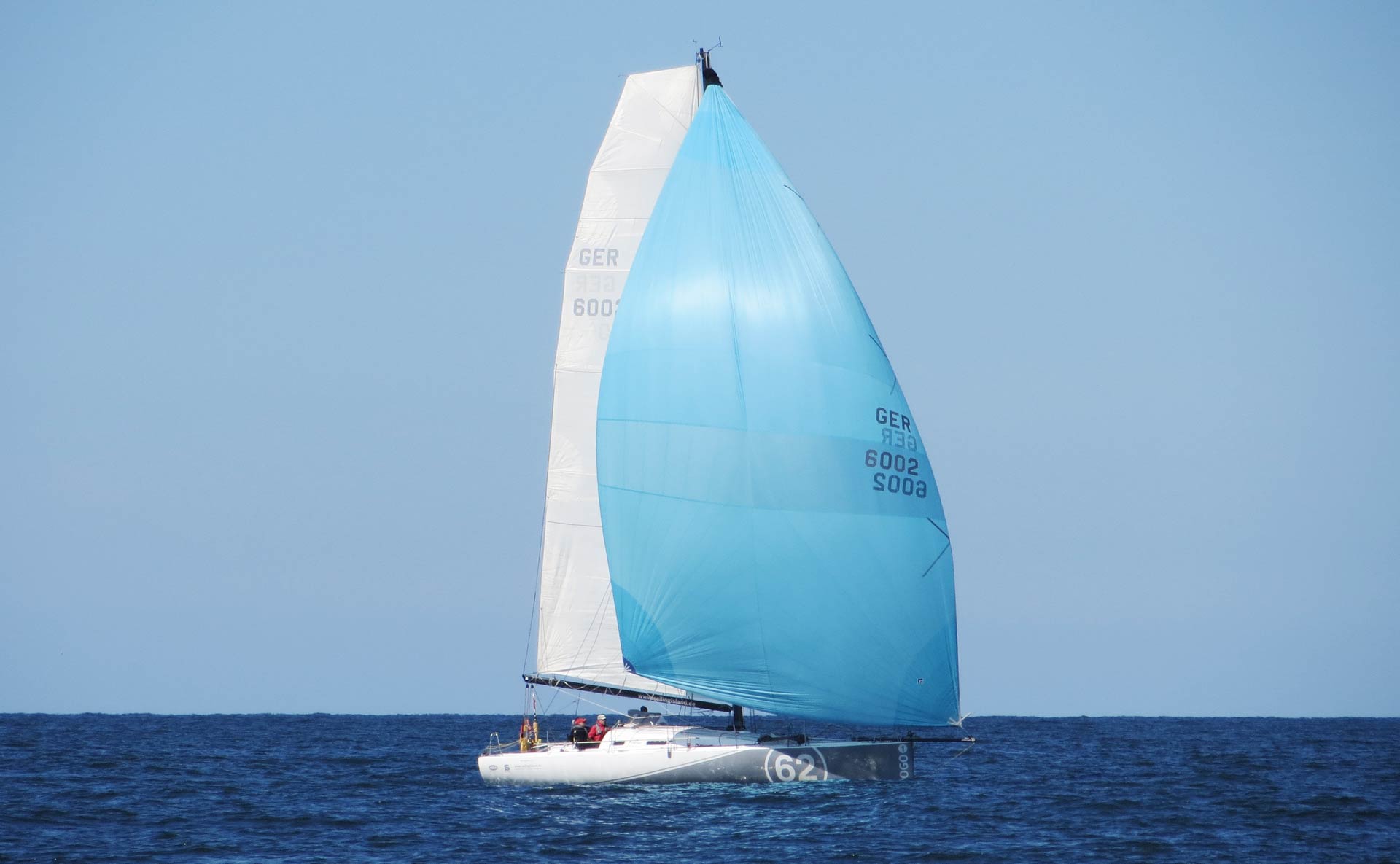
As weather was surprisingly nice, just a low puff of some 6 to 9 knots true, I decided it might be a good idea to test the Gennaker light wind sail of GEKKO. Now, Gennaker-sailing is pure fun and always – at least for me – a highlight when sailing. In relatively calm conditions this sail manages to propel a boat to nearly the speed of the wind itself, the big, colorful sail is a treat to a sailor´s eye and controlling the Gennaker, permanent trimming and immediately seeing the outcome is pure sailing fun. As I have sailed under Gennaker numerous times, I thought it would be the next step in single hand training on GEKKO to first time take out my blue Gennaker.
Preparing Boat and Sail on the Jetty
Now, as this sail was still packed in its original condition coming from the manufacturer, I took it out on the quay and unfurled the stack of fine garment. I went for the light blue Gennaker, which was a decision made prior to my decision of naming my boat GEKKO – later I tried to have the color changed to – of course – green, but it had already been processed and produced, so here we are now with a blue one. It´s nice anyway …

After checking the garment I searched for the attachment points of the lines of which there are of course three: Tack is the bottom of the sail which is going to be attached to the pole (or bowsprit in bigger yachts), Clew is where the sheets are to be mounted to and finally the Head, as its name already suggests, that´s the halyard attachment point going all the way up to the mast head. I took the package aboard, stuffed it to the sail bag and began attaching the ropes.

In doing so, I already pre-thought how the conditions outside (especially from where the wind was blowing) would determining the side of the boat on which I would be hoisting the sail. This is important because the sail and its lines attached must be free of any obstacles posed by Jib sheets, and the forestay. It must go up completely unhindered by the standard rigging of the boat.
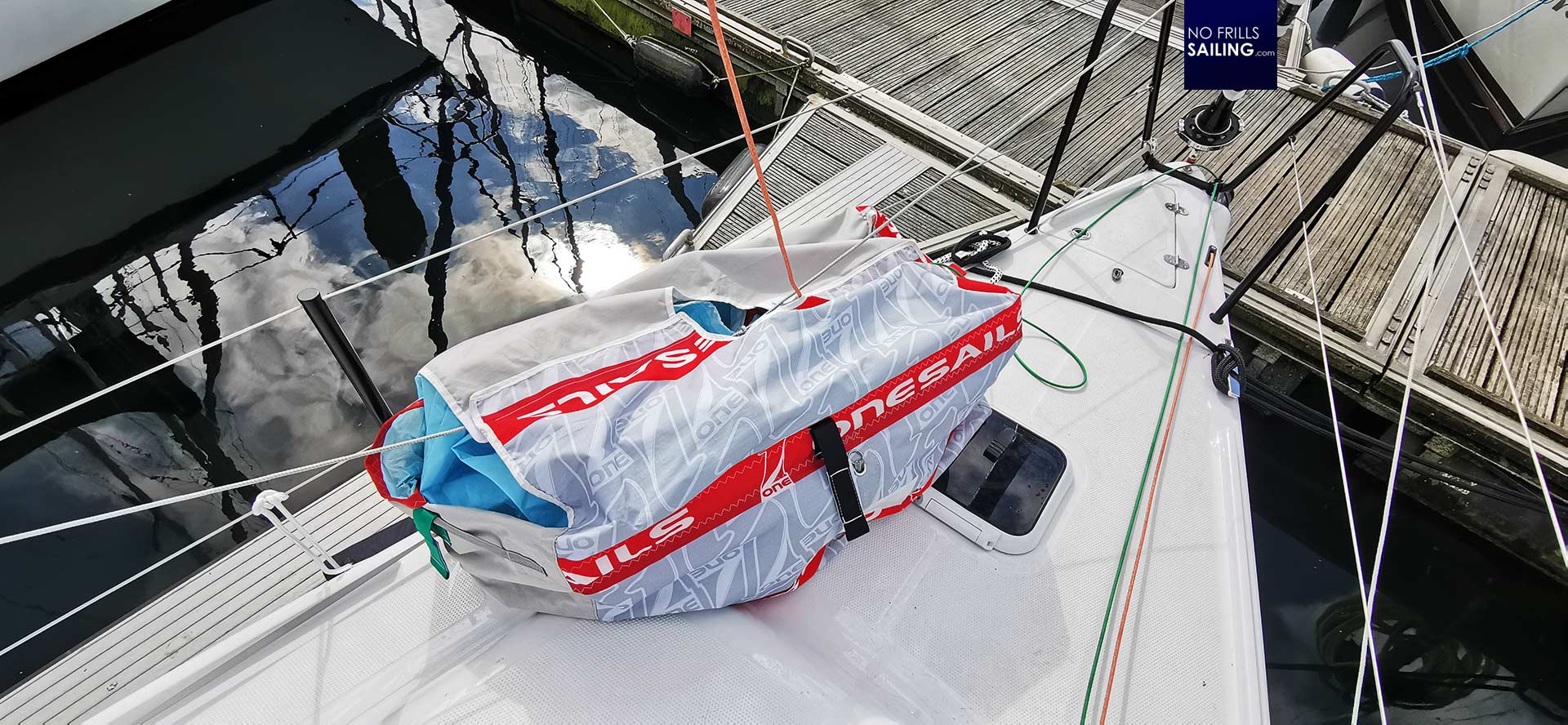
A fore sail, no matter which, is always brought up into the wind on the leeward side of the boat, which in my case, I thought, would be port side. So I at first took aft the tackline which runs through a loop on the tip of the pole and back to the cockpit and attached it. The sheets (conveniently delivered by Seascape in red an green so that they normally couldn´t be mistaken went through the block at the stern all the way forward and onto the clew. The windward sheet, in my case the green one, was of course lead outside around the forestay back to the block.

When this was done I tested the pole-out, pole-in feature of the boat right there still moored at the jetty and it worked just fine. Now, let´s untie the boat, leave the berth and get out!, I thought, rigged the Torqeedo-engine in place, casted off and went out to the Luebeck Bay, accompanied by a glorious sun and thick white Cumulus clouds, creating mild gusts from time to time, but wind still blowing at a nice 6 to 8 knots.
Hoisting the Gennaker for the First Time
After some minutes steaming out of the marina, I went into the wind and brought up the mainsail, which on the First 27 SE is a matter of half a minute max. It is such a difference to the standard Dacron-sails with the plastic sliders on the big boats: The sail goes up (and down!) so easily, which of course helps a lot when sailing in single handed mode. Luffing and sailing under mainsail exclusively, I slowly went out to the open sea.
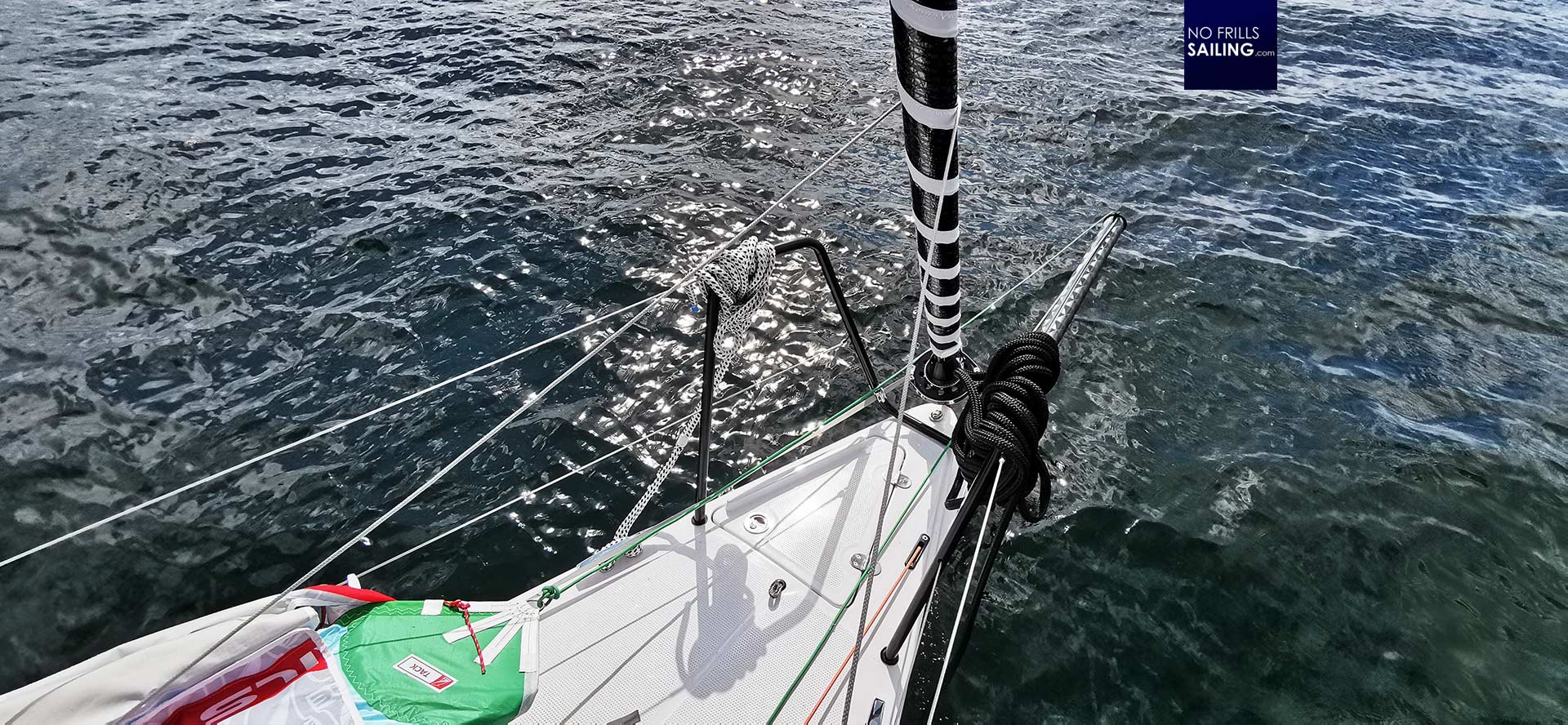
I took out the pole and went to the foredeck again for a last check: Are the sheets really tied up the right way? Is the halyard on its way up not entangling with some other line? Is the windward sheet free and running outside the standing rigging? Yes, everything was on go, so I opened up the large Velcros of the Gennaker sail bag, brought the halyard under tension and let pass by a Coast Guard ship coming in before taking up the sail.

After clearing the big wake of the police vessel, I pulled the halyard and up it went. I placed myself at the working winch in a way that I was still able to control the tiller for some course corrections if necessary. My autopilot (same goes for the whole B&G system aboard GEKKO) wasn´t calibrated nor initialized so I had no Mr. Computer Helmsman available. Nevertheless, thanks to the low wind speed, the boat held course perfectly and I was able to concentrate on the Gennaker.

It went up pretty fast, came out of the bag just perfectly and unfolded in the wind. A manoeuvre by the book – except for one flaw. As it turned out, I apparently tied the wrong halyard to the Gennaker´s head: The shorter one reserved for the Code 0 (Fractional Spi) and not the Spi Top halyard. In this slightly more than a full meter was now missing and I of course could not bring the right tension to the luff. The sail was up and working – but it looked a bit like a balloon loosing air …
Sailing a Gennaker single handed
Well, that´s for the second brain. I knew how this mistake happened: Taking down the Jib cover, I untied the halyard from the cover and mixed it up in my head. Maybe my brain said: “You already have a rope at hand that goes up, take this one!” and so I tied it to the Gennaker head. Now, with the sail up and the boat springing to life immediately, I first cursed a bit but the decided to go on sailing this way, leaving the sail up and take this opportunity to have it burned to my head: Spi Top for Gennaker the next time!

With the Gennaker up in the wind and – best of what I could do with the situation now – I sat down, luffed even more and trimmed the sail. The boat jumped forward and accelerated. It is always with such great pleasure causing me to smile brightly when a light wind sail is hoisted, the effect it has on a boat amazes me every time again. What was before a mere near-drifting instantly becomes a race. The murmur and gurgling at the stern, instant nimble steering response on the rudders, just pure bliss!
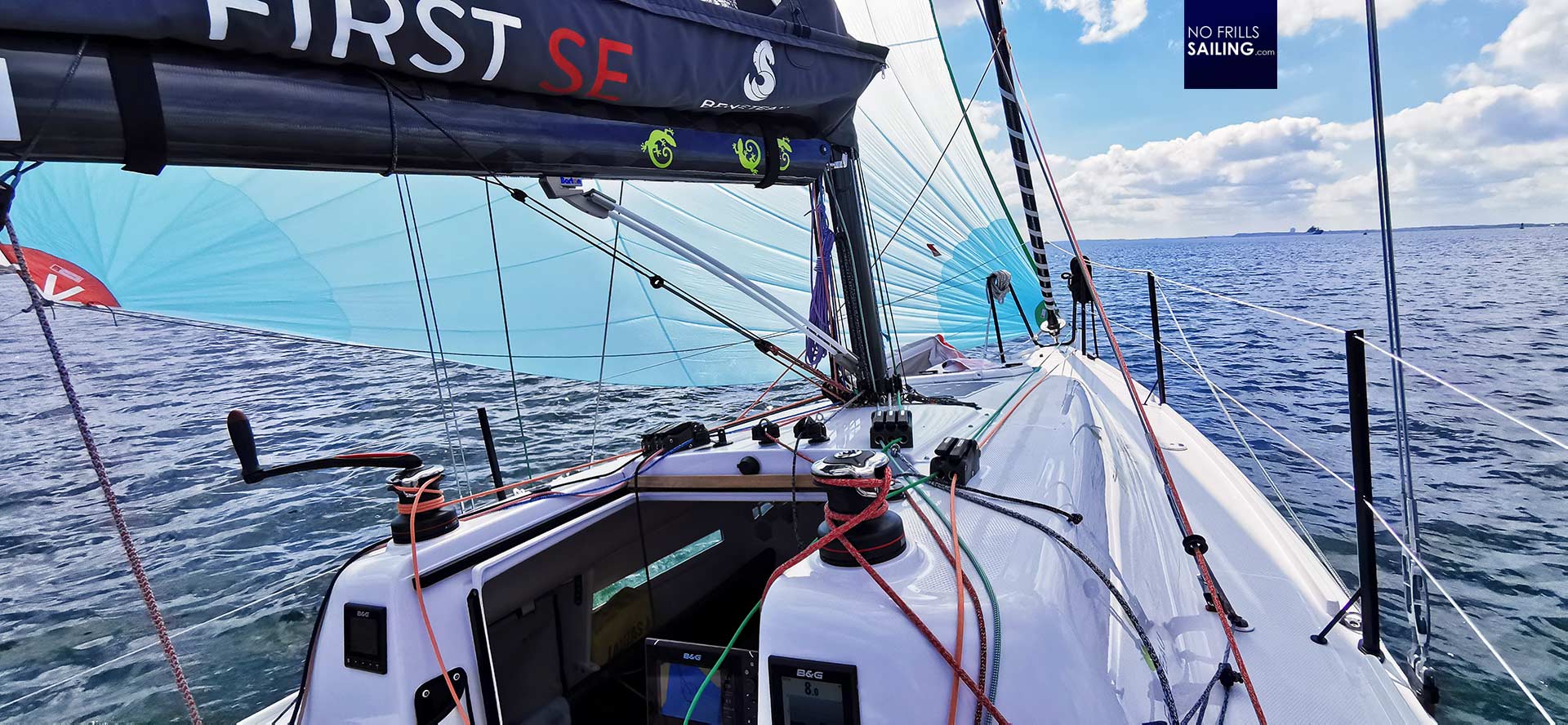
I began to check out how deep I could sail the Gennaker and even luffed to the maximum to see when the sail looses its ability to create forward drive. Amazing how much of a near upwind-course I was able to sail thoroughly with a Gennaker that wasn´t even hoisted with the right halyard!
Gennaker Performance on First 27 SE / Seascape 27
As expected, the performance was astonishing. Wind speeds that day hovered around 7.5 knots true in average and the boat managed to sail at 6 knots in average, which is one knot less than the speed of the wind. I know that these sails in light wind conditions produce so much speed, but it is every time a breathtaking experience.

I took in the mainsail a bit more to allow a better flow of wind onto the Gennaker, veered away and let her run down on a broad reach. The tension in my body slowly released a bit and I could relax. Sitting down on the windward coamings I watched the boat gliding effortlessly over the waves, the wake was amazing although we hadn´t entered planning mode yet, which, honestly, was completely okay for me. Still, it was a First Time and as I mentioned earlier, I did not wanted to overtax.

I outmanoeuvered some fishing boats with the men waving and greeting, which was unusual for these kind of people who normally just nod or shortly raise a hand. I guess the design of my boat and the sheer positive look it transports cheers people up. Judging also from the numerous chats and talks by the berth I receive when on board, this boat draws in quite some attention and – lucky me – until now just positive reactions.
Single handedly controlling the Gennaker
With some minutes of relaxation and simply enjoying the sun, the boat and the sailing, I “returned” my consciousness aboard and re-focused on the matter. I am a friend of a cleared up boat with all lines ready for usage, I would say I “hate” sheet mumble in the cockpit, but it kind of hurts my eyes and triggers my sense for tidiness.

But it´s a feat of a racing boat like the First 27 SE that traveler sheet, mainsheet and the jib sheets cannot go anywhere else than on the cockpit´s floor. Nevertheless, I tried to get a system to this mess. Clearly a point to work on the next time I go out. Time flew by and I mean this literally. The boat was so fast that surely and fast the marina went out of sight – my appointment nevertheless moved closer ever so slightly.

I decided to go home, luffed again and went the most upwind I could get with Gennaker hoisted. It all wasn´t a problem. When approximately half of the distance back was achieved, I decided to take in the Gennaker. Preventing stress at any time is my sailing motto since I sail as a skipper and as such, since this was the first time retrieving the big blue sail alone, I wanted to do this in open water with no risk to harm anyone else.
Tricky manoeuvre: Retrieving the Gennaker
Taking in a Gennaker without a sock is a tricky thing. I have done this double handed back in the days when sailing the Oceanis 30.1 to Sweden and it was always a “big adventure”. The theory is easy: Going on a near-downwind course, slowly releasing the halyard and taking down the Gennaker by grabbing the clew first. That´s already some exciting work for two people – but an even bigger challenge for one man alone.

I veered away as much as I could but since GEKKO hasn´t got an autopilot working right now, I refrained from a true downwind point of sail. I took the halyard from the winch and opened the clamp – quite some force on the line! With the halyard in my hand I went to the foredeck and released tension. Of course the foot of the sail touched the water, so I began pulling even harder at the Clew, slowly taking in more and more sail.

I refrained from putting the sail back into the Bag which would have been too much stress for me at this point. Luckily, the First 27 SE has a Gennaker-compartment which is ingenious. Just down the main hatch the sail can be stuffed into the hull. That takes not more than a minute. I sprang back and corrected the course as the sail was down, then returned and untied sheets, tackline and halyard and closed the hatch. Sail down, everything was fine.
Learning from my First Time out alone under Gennaker
I pulled out the standard Jib and decided to have round of sailing under normal cloth too as wind freshened up a bit to 10 Sailing past by our local SAR cruiser (people waving) and some more fishermen, it is without saying that steering GEKKO is much like being at the helm of a small dinghy, pretty much reminding me in her responsiveness and nimble dancing on her rudders of my very first sailing certificate done on a jollyboat.
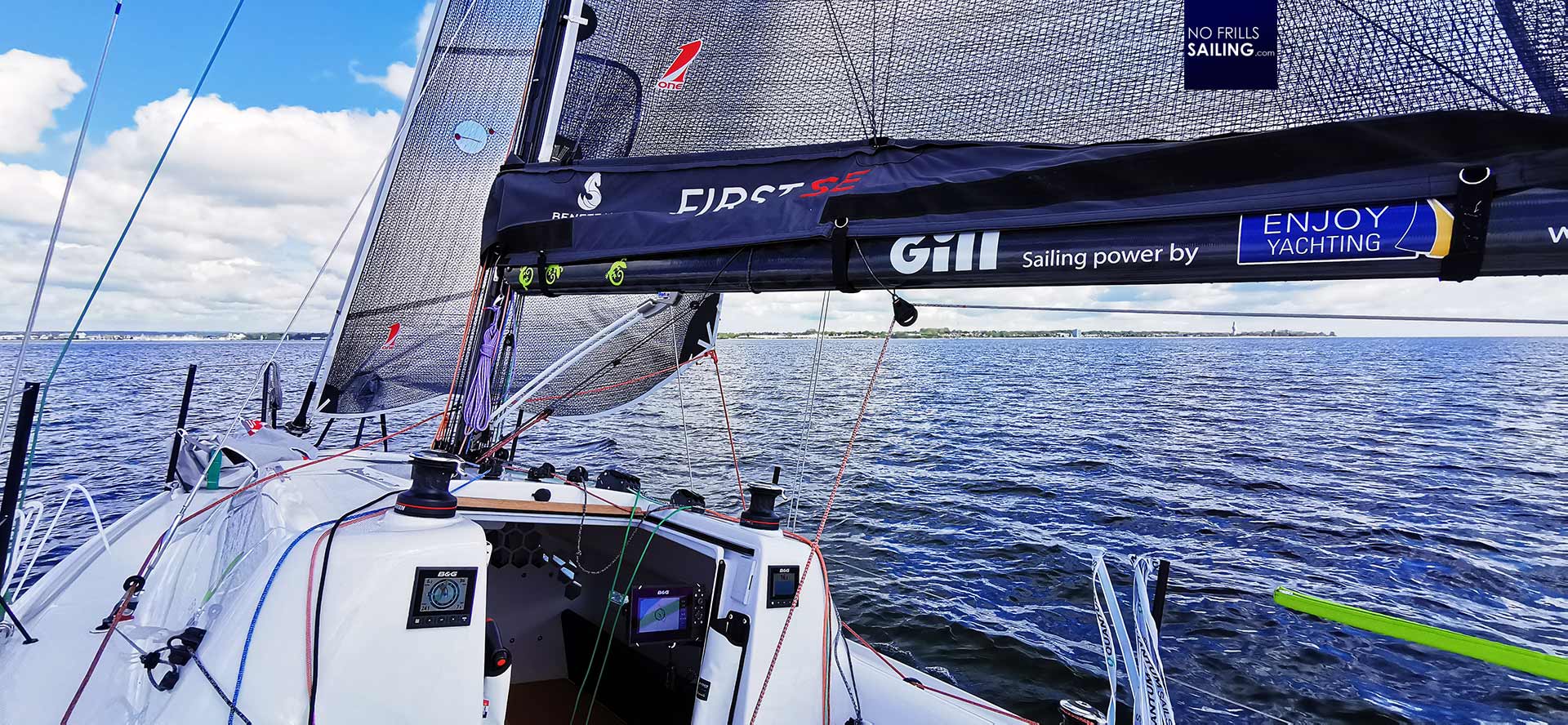
I returned to the waterway leading into my home marina, luffed to upwind course, opened the mainsheet an let fly the main sail. The boat helmed herself so that I loosened the main halyard and by – very gently – pulling at the leech the big mainsail fell right down the mast into its bag. Perfect. Then I opened the shaft for the prop unit and brought the Torqeedo online which, now that I am doing it the eighth or so time, was a matter of seconds. Taking in the Jib I steamed gently into the port, contemplating what I had just done.

What can I learn from my first time out single handedly sailing a Gennaker? Well, above all, proceedings and steps to hoist and retrieved the big lightwind sail had been quite right. I was satisfied by my performance pretty much, taken aside the faux pas of tying the wrong halyard to the sail´s head. I guess I will never forget to use the green instead of the orange line … Sailing the Gennaker was easy as ABC and so I am pretty convinced that the next time taking it out I will perform better. Only real challenge, I think, is the retrieval part. For doing this safely even in heavier seas and a stronger breeze, I need to get the autopilot on line as letting the boat steer itself flat downwind isn´t such a good idea, always having a Chinese Gybe looming.

Nevertheless, a pretty cool two hour ride outside, great pictures taken and a full sailing lesson in my books for sailing alone. Next up is the B&G-setup, a replacement of a shackle (instead of a very long soft-shackle as of now) at the tack of the Jib and finally attaching blocks to the mainsail to put in the reefing lines. It won´t get boring aboard GEKKO … For now, back at the berth, I stowed away the Gennaker in its sail bag into the dedicated compartment. No time for sitting down in the cockpit and letting the pictures fly by as my appointment was right on time and I jumped off board. What a great forenoon!
You may also like to read the following articles:
All Seascape-/First-related posts by clicking the hashtag #thinkseascape
Gennaker training on a Pogo 40
Code 0 training on an Oceanis 30.1
